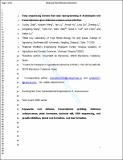Por favor, use este identificador para citar o enlazar a este item:
http://hdl.handle.net/10261/206527COMPARTIR / EXPORTAR:
 SHARE SHARE
 CORE
BASE CORE
BASE
|
|
| Visualizar otros formatos: MARC | Dublin Core | RDF | ORE | MODS | METS | DIDL | DATACITE | |

| Título: | Deep sequencing reveals early reprogramming of Arabidopsis root transcriptomes upon Ralstonia solanacearum infection |
Autor: | Zhao, Cuizhu; Wang, Huijuan; Hu, Jinxue; Qu, Ling; Li, Zheqing; Wang, Dongdong; He, Yizhe; Valls, Marc CSIC ORCID; Coll, Núria S. CSIC ORCID; Chen, Qin; Lu, Haibin CSIC ORCID | Fecha de publicación: | 2019 | Editor: | American Phytopathological Society | Citación: | Molecular Plant-Microbe Interactions 32(7): 813-827 (2019) | Resumen: | Bacterial wilt caused by the bacterial pathogen Ralstonia solanacearum is one of the most devastating crop diseases worldwide. The molecular mechanisms controlling the early stage of R. solanacearum colonization in the root remain unknown. Aiming to better understand the mechanism of the establishment of R. solanacearum infection in root, we established four stages in the early interaction of the pathogen with Arabidopsis roots and determined the transcriptional profiles of these stages of infection. A total 2,698 genes were identified as differentially expressed genes during the initial 96 h after infection, with the majority of changes in gene expression occurring after pathogen-triggered root-hair development observed. Further analysis of differentially expressed genes indicated sequential activation of multiple hormone signaling cascades, including abscisic acid (ABA), auxin, jasmonic acid, and ethylene. Simultaneous impairment of ABA receptor genes promoted plant wilting symptoms after R. solanacearum infection but did not affect primary root growth inhibition or root-hair and lateral root formation caused by R. solanacearum. This indicated that ABA signaling positively regulates root defense to R. solanacearum. Moreover, transcriptional changes of genes involved in primary root, lateral root, and root-hair formation exhibited high temporal dynamics upon infection. Taken together, our results suggest that successful infection of R. solanacearum on roots is a highly programmed process involving in hormone crosstalk. | Versión del editor: | https://doi.org/10.1094/MPMI-10-18-0268-R | URI: | http://hdl.handle.net/10261/206527 | DOI: | 10.1094/MPMI-10-18-0268-R | ISSN: | 0894-0282 | E-ISSN: | 1943-7706 |
| Aparece en las colecciones: | (CRAG) Artículos |
Ficheros en este ítem:
| Fichero | Descripción | Tamaño | Formato | |
|---|---|---|---|---|
| deepinfect.pdf | 4,87 MB | Adobe PDF |  Visualizar/Abrir |
CORE Recommender
PubMed Central
Citations
16
checked on 02-may-2024
SCOPUSTM
Citations
21
checked on 03-may-2024
WEB OF SCIENCETM
Citations
20
checked on 24-feb-2024
Page view(s)
185
checked on 06-may-2024
Download(s)
140
checked on 06-may-2024
Google ScholarTM
Check
Altmetric
Altmetric
Artículos relacionados:
NOTA: Los ítems de Digital.CSIC están protegidos por copyright, con todos los derechos reservados, a menos que se indique lo contrario.
